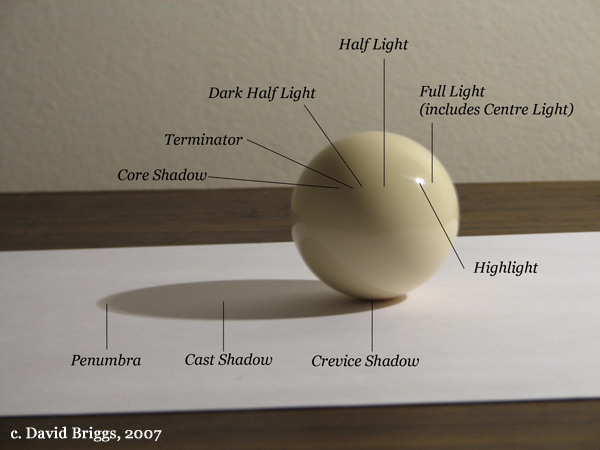my colour short course is
now offered online through
Australia's National Art
School in Sydney! There's
a choice of two sessions to
suit every time zone. LINK
Home
The Dimensions of Colour
Basics of Light and Shade
Additive Mixing
Subtractive Mixing
Mixing of Paints
Hue
Lightness and Chroma
Brightness and Saturation
Principles of Colour
Afterthoughts
Glossary
References
Contact
Links
NEXT COLOUR
WORKSHOPS

THE ZONE OF LIGHT

Figure 2.4. Glossy sphere under a single direct light source, showing terminology of light and shade. Photograph by David Briggs.
Light from a light source travels in straight lines and divides any subject into a zone of light and a zone of shadow (Figure 2.4). The zone of shadow is further divided into a form shadow - an area in shadow because it is turned away from the light source, and a cast shadow - an area in shadow because the light source is blocked by another object.
The boundary between the zone of light and the form shadow is known as the terminator. On spheres the zone of light occupies roughly half the sphere (less than half if the light source is small and close; more than half if the light source is large in apparent or angular size). In any case the terminator on a sphere considered as a whole is a circle, and so the visible part generally has the apparent shape of a section of an ellipse. (In Figure 2.4 the light comes from almost exactly side-on to the sphere, and so the terminator appears as an almost straight line). The pattern of light and shadow visible depends on the relationship of the direction of the light source to the direction of the viewer. Experiment with the sliders in Figure 2.5 to see the effect of the position of the light source on the shape of the light and shadow zones.
The character and direction of the terminator depends strongly on the form of the object. Because of the steady curvature of the surface, the terminator appears as a relatively soft edge on a sphere, an ovoid, a cylinder or a cone (though becoming progressively crisper towards the apex of the latter). The direction of the terminator runs on a sphere at right angles to the direction of light fall, on a cylinder parallel to the central axis, and on a cone radiating from the apex. On a prismatic object the terminator tends to follow plane breaks, and is crisp in proportion to the sharpness of the latter. On objects that are intermediate in form, the terminator follows a path that is a compromise between these basic patterns.
Figure 2.5 Effect of direction of light source. Drag the slider around the sphere to see the effect of changing the direction of a close light source on the shape of the light zones and the position and strength of the highlight, generated by Ray Kristanto using Maya. Copyright David Briggs and Ray Kristanto, 2007.
Variation in the brightness of the diffuse reflection within the zone of light creates the modelling of form. Irrespective of the position of the observer, the diffuse reflection is always brightest on the plane directly facing the light source, where light strikes the surface at 90 degrees. Outward from this point, light hits the surface at progressively greater inclinations, so that there is less incident light per unit area, hence less light reflected, and hence a darker appearance. However this fall-off is at first almost negligible, and the surface must curve away fully 60 degrees before the amount of incident light energy is halved; beyond this point the fall-off of light is increasingly rapid. Artists find it useful to divide this continuum into a series of light zones, comprising at least a full light , a halflight, and commonly a dark halflight alongside the terminator, and a centre light for the very lightest part of the full light. When a painter has found the right colours for each of these zones, plus the shadow, finding the transitional colours is easy, and even optional.
